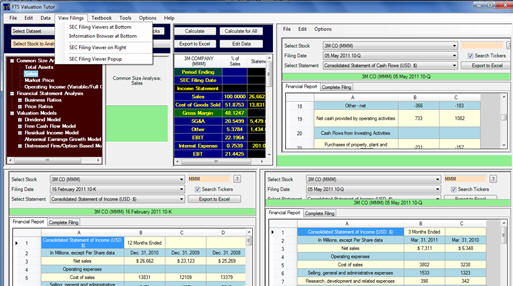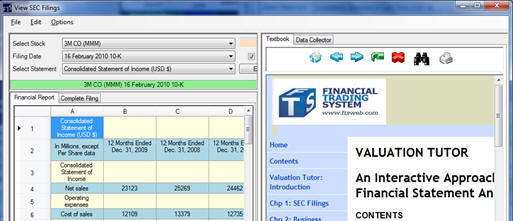3.12 “Earnings Season” and the Importance of
Financial Statements to the Capital Markets
Today’s stock markets are
very sensitive to “earnings’ season.”
This happens every quarter when the companies release their
previous quarter’s earnings.
The important numbers the market watches are, Sales Revenue
and Quarterly Earnings in relation to consensus forecasts.
As discussed in the introduction to Valuation Tutor there
are different models used to estimate what a stock is worth.
The simplest is called the “dividend model,” covered in
Chapter 6. This model
takes the view that if you buy a stock, you are entitled to receive
future dividends paid by the stock.
From this perspective a stock’s “fair value” equals the
present value of the future dividends.
Applying the
above logic requires forecasting future dividends and also the
rate(s) at which these will be discounted.
Future dividends are paid from future earnings which in turn
depend upon future sales revenue.
As a result, stock prices depend
upon both earnings’ and sales forecasts.
Forecasting the future, however, is very difficult and in an
influential old book by Burton Malkiel, A Random Walk Down Wall
Street, he discussed implications for stock prices from the random
walk hypothesis. This hypothesis applied to the stock market
introduces the controversial idea that that one cannot consistently
outperform market averages.
Irrespective of ones view of this hypothesis it does serve to
underscore the importance of beating the consensus forecast when
observing changes in stock prices in relation to the release of
additional financial statement information over time.
From a reporting
perspective Valuation tutor provides access to these important
quarterly statements from the 10-Q filings that define “earnings’
season” for three quarters throughout the year.
The fourth quarter is defined from the 10-K filings.
It is noted, however, that the 10-Q financial statements are
unaudited and therefore it is not uncommon for earlier quarters to
be revised.
Valuation Tutor provides
easy access to both the quarterly financial statements (illustrated
below) and current consensus forecasts
from different sources on the web.
To access this information from the main screen you use the
menu item “View Filings.”

The sub-menu items let you
configure the screen in different ways:
·
SEC Filing Viewers at
Bottom --- this lets you bring up the interactive statements at the
bottom of the main container.
You then have immediate access to both annual and quarterly
interactive statements including one click exporting to Excel.

·
Information Browser at
Bottom – this gives immediate access (in a web browser) to a wide
range of relevant information that is available on the web including
Consensus Forecasts.

·
SEC Filing Viewer on Right
--- for some analysis and reconciliations it is convenient to have
the three major financial statements up – Income, Balance Sheet and
Cash Flow or a major statement as well as some of the supporting
schedules. This feature
lets you replace the Textbook with a third supporting statement.

·
SEC Filing Viewer Popup –
finally if you require even more information up simultaneously you
launch pop up windows containing additional filings, companies and
including access to the online textbook information
 .
.
In summary, earnings
season only serves to reinforce the importance of financial
statement analysis, having immediate access and the knowledge
required to process lots of information that is available in today’s
world. In the next
Chapter we focus upon how the building blocks introduced in this
Chapter are actually applied to real world decision making and
analysis.
